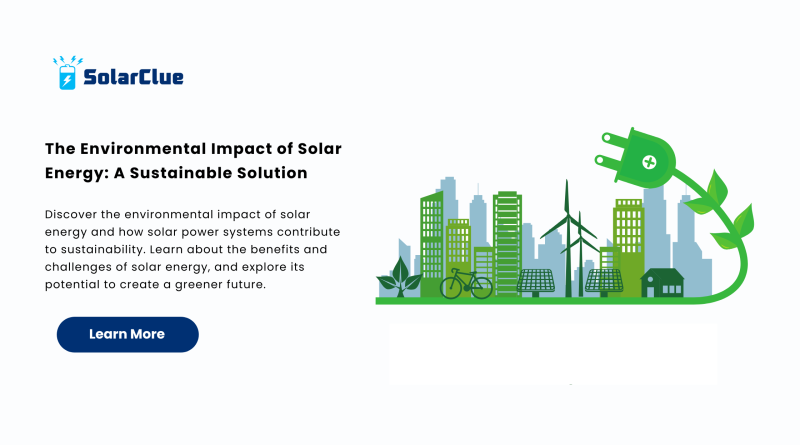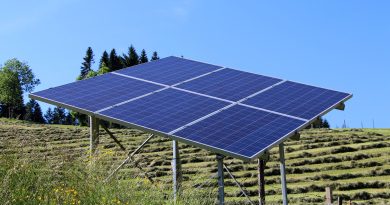The Environmental Impact of Solar Energy: A Sustainable Solution
Solar energy is one of the most powerful tools in the fight against climate change. As the world turns to renewable energy sources, solar power emerges as a clean, sustainable solution to reduce carbon emissions. But what exactly is the environmental impact of solar energy? In this blog post, we’ll delve into how solar energy works, its environmental benefits, and the challenges that come with its adoption. Let’s explore how investing in a solar power system can help preserve the planet for future generations.
Table of Contents
Understanding Solar Power Systems
A solar power system captures sunlight using solar panels to generate electricity. This process is fundamentally clean because it doesn’t rely on burning fossil fuels or emitting harmful gases. The main environmental benefit of solar energy is that it reduces the need for conventional energy sources, thus decreasing air pollution and greenhouse gas emissions. By harnessing the sun’s energy, we can reduce our dependence on non-renewable resources, creating a cleaner and more sustainable world.
The Environmental Benefits of Solar Power
Reduction of Greenhouse Gas Emissions
The most significant benefit of solar power is its ability to reduce greenhouse gas emissions. Unlike traditional fossil fuels, solar energy generates electricity without releasing carbon dioxide (CO2) into the atmosphere. A solar power system significantly reduces the carbon footprint of a home or business, contributing to the fight against global warming. According to studies, for every megawatt-hour of solar electricity generated, around 1.5 to 2.5 tons of CO2 emissions are avoided, depending on the local energy mix.
Sustainable Energy Source
Solar energy is a renewable resource, meaning it will never run out as long as the sun shines. This makes it a sustainable alternative to fossil fuels, which are finite and depleting. By shifting to solar energy, we can ensure a long-term, sustainable energy future for generations to come.
Reduction in Water Consumption
Unlike coal, nuclear, or natural gas power plants, solar power systems don’t require water for cooling. Traditional power generation plants consume vast amounts of water to generate electricity, which is especially problematic in areas experiencing water scarcity. Solar panels, on the other hand, require minimal water to maintain and operate, making them an excellent option in water-stressed regions.
Less Habitat Disruption
While all energy production has some level of environmental impact, solar power is one of the least disruptive to ecosystems. Unlike coal or oil extraction, which often involves significant land disturbance, solar panels can be installed on rooftops or in desert areas with minimal impact on wildlife and ecosystems. This makes solar energy an eco-friendly alternative with much lower environmental costs.
The Environmental Challenges of Solar Energy
While solar energy is incredibly beneficial, it’s not entirely free of environmental impact. There are still some challenges to consider in the production and disposal of solar panels.
Energy-Intensive Manufacturing Process
The production of solar panels requires energy, which currently comes from a mix of sources, including fossil fuels. The materials used to make solar panels, such as silicon and rare metals, also require significant mining and processing. However, as technology improves, solar panel manufacturing is becoming increasingly energy-efficient and environmentally friendly. Recycling techniques are also evolving, helping to reduce the environmental footprint of manufacturing.
Waste and Recycling Concerns
At the end of their lifespan, solar panels can become waste. Although most solar panels last 25 to 30 years, when they reach the end of their useful life, it’s essential to recycle them properly. The good news is that many parts of solar panels can be recycled, including the glass, metals, and silicon. However, the infrastructure for large-scale solar panel recycling is still developing, and improper disposal could lead to environmental challenges.
Land Use for Solar Farms
Large-scale solar farms require significant land area, which can sometimes lead to conflicts with agriculture or wildlife preservation. However, solar installations can also be co-located with other activities, such as agriculture (known as agrivoltaics) or grazing. Careful planning and site selection can help mitigate any negative environmental effects of solar farm installations.

How Solar Power Contributes to a Greener Future
Solar power plays a key role in reducing carbon emissions and mitigating climate change. By switching to solar power, we can significantly lower the pollution levels in our environment. This transition to cleaner energy sources contributes to improving air quality and public health, reducing reliance on non-renewable resources, and ensuring a more sustainable future for the planet.
In addition, investing in solar energy helps promote energy independence. With a solar power system, homes and businesses can produce their own electricity, reducing dependence on fossil fuel-based energy and providing a stable, reliable power source. This transition not only reduces environmental harm but also supports economic growth through green energy jobs.
FAQs on the Environmental Impact of Solar Energy
Q1: Is solar energy 100% clean and environmentally friendly?
While solar energy is among the cleanest sources of power, the production of solar panels does involve some environmental impact. The mining of raw materials and energy-intensive manufacturing processes can create pollution. However, once installed, solar panels produce no emissions and have a very low environmental impact compared to traditional energy sources.
Q2: Do solar panels reduce greenhouse gas emissions?
Yes, solar panels significantly reduce greenhouse gas emissions by replacing fossil fuel-based energy sources. For every unit of electricity generated by solar energy, we avoid the release of harmful CO2 into the atmosphere.
Q3: What is the lifespan of solar panels?
Solar panels typically last between 25 and 30 years. During this period, they produce clean energy and significantly reduce carbon footprints. After their lifespan, recycling and proper disposal are essential to minimize environmental impact.
Q4: Can solar energy help with water conservation?
Yes, solar power systems do not require water for electricity generation, unlike traditional power plants. This makes solar energy an essential component in areas experiencing water shortages.
Q5: Are solar panels recyclable?
Yes, solar panels can be recycled, and many parts, including glass and metals, can be reused. However, the infrastructure for solar panel recycling is still developing, and efforts are underway to improve recycling methods and efficiency.
Conclusion
In conclusion, solar energy offers an array of environmental benefits, including the reduction of greenhouse gas emissions, water conservation, and a sustainable energy future. While there are some challenges in the production and disposal of solar panels, these are being addressed with innovations in manufacturing and recycling technologies. By embracing solar power, we are taking an essential step toward building a cleaner, greener, and more sustainable world.
If you’re looking to make a difference with solar energy, explore the wide range of products and services available at SolarClue. For more insights on solar energy, visit our blog at blog.solarclue.com.




